Although the season is over and the start of 2020/2021 seems far, far away, one can always improve as a player. In today’s topic, we’ll talk about penalty shots.
We’ve piled up a list of 10 tips to improve your penalty shots. Most tips can be practiced from home, so read on and become your team’s penalty expert next season!
We’re starting off with a game situation:
You’re playing a tight game against a tough opponent. The score’s 6-6 and with less than 10 seconds to play, your team receives a penalty shot!
It’s a big opportunity to score and the whole team wants you to take it… A big lump settles in your throat. The hall is completely silent as you set foot on the field. Focus now!
You touch the ball once and you start up running towards the goal. When you enter the slot you quickly think about the move you are going to make, but… DANG! The goalie’s foot hits the ball and with the tail between your legs, you start to make the ‘walk of shame’ back to your teammates.
What went wrong?
Granted, we’re not all penalty stars like Alexander Rudd. But why does this seem to happen all the time?!

In this article, I’ll highlight 10 ways to improve your penalty shots. If possible, I’ll add examples to each tip and tell you why you should focus on this specific piece of advice.
Furthermore, as most of us have to sit at home due to the corona crisis worldwide, I’ll also give you specific advice on how to practice some of these tips at home.
So let’s get started: we’re moving on to the 10 tips right away!

1. Form A Plan
This is the basis of every penalty shot. Just like you agree on a tactic in offense and defense in a game with your team – for example, the 2-1-2 system we explained earlier – you also come up with a plan for your penalty shot.
Think in advance and create a plan about the move you want to do. Sure, you can always (in a split-second) decide you’re switching to a back-up penalty, but having an idea in mind gives you confidence and a safe plan to fall back on.
How are you gonna do this? For example, let’s start off with a relatively easy penalty shot. You can opt for the following scenario:
- Walk up via the left side, towards the goal.
- Spot the space next to the goalkeeper
- Shoot
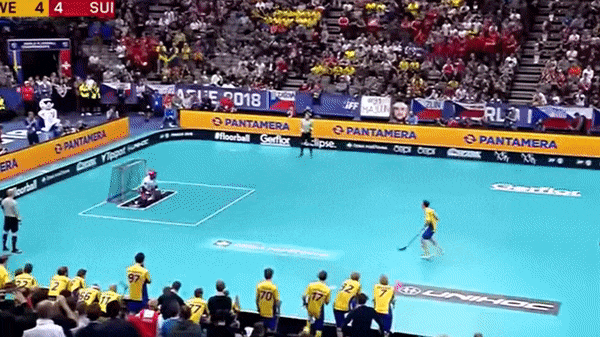
Galante spots the space in the right top corner and has no trouble putting the ball in the net. If all else fails, you can always go for the direct shot, that’s why I put it on the first spot in this top 10 list. But make sure you have a plan.
How to practice this at home – As the practical part will be a problem, we’ll have to focus on the theoretical part, which means: start watching all Top 10 Penalty Shots videos all over again! At the bottom of this article, I’ll post a few of them.
2. Take Your Time (You’re in Control)
The ref blows his whistle and you start to sprint towards the goal… but why? It might be the nerves, or as you’ve seen your teammates do it, but really: there’s no rush.
Take your time. Start slowly, maybe make a zigzag motion to try to bring the goalie out of his position. You want the goalie to get confused, not knowing anymore where his goal is located (exactly). Optionally, try a fake shot every now and then to really get to his nerves.
READ – How the Royal Road Might Increase Your Goal-Scoring Opportunities
My concrete piece of advice, in this case, is: understand you don’t need to move directly towards the goal, you can make movements to the left and right as well to increase your goal-scoring chance:
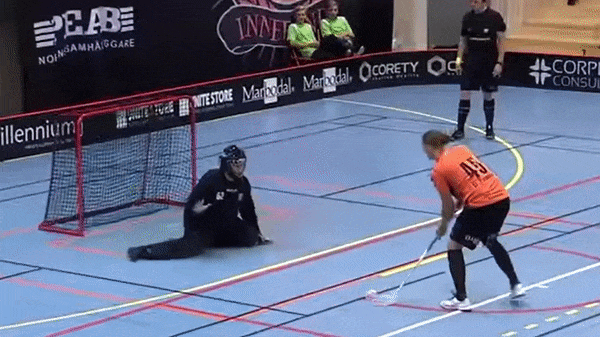
By quickly moving the ball to the right and left, Daniel Persson tricks the goalkeeper and finds the easy way to the goal.
How to practice this at home – Improve your stick handling (more of this in Tip 7). Make sure you’re able to move the ball to the left and right without too much trouble – you can even make it a challenge for yourself: how many times can you do this in 1 minute?
3. Get the Goalkeeper to the Ground
In this 1-vs-1 situation, it may be useful to (try to) outplay the goalkeeper. As soon as the goalkeeper is on the ground, your chances of scoring increase enormously.
So try to lure the goalkeeper with a feint or by quickly moving the ball across the pitch from side to side, tricking your opponent to fall down.
As soon as the goalkeeper is lying down, all you have to do is lift the ball over him or play it past him. This doesn’t necessarily have to be using a hard shot; a well-placed lift or shot is better in this case.
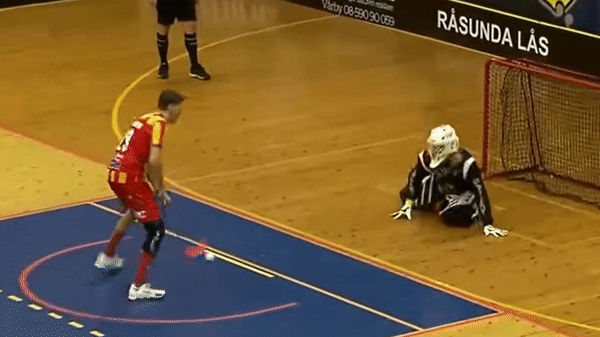
In tip 8, I will go into more detail about the goalkeeper.
How to practice this at home – Specifically for this, you should work on your feints. Pretend you’re about to move the ball to the right, but instead, quickly turn to the left and vice versa. Stay light on your feet (more in tip 9) and make sure you’re in control of the ball.
[ppp_non_patron_only]As much as we love floorball, we dedicate a lot of time and money to the FloorballToday project (more info here). That's why we ask you for a small monthly donation. By clicking the button below you can become one of our supporters and read the rest of the article. Thanks a lot! Already a patron? Then here is where you can login. [/ppp_non_patron_only][ppp_patron_only level="6" silent="no"][ppp_patron_only level=”6″ silent=”no”]
4. Time Your Move
You have a reach of about two meters, making it relatively easy to move the ball around the goalkeeper. However, if you start your move too late, the goalie can (and WILL!) extend his legs, making it impossible for you to get past.
Don’t. Start. Too. Late.
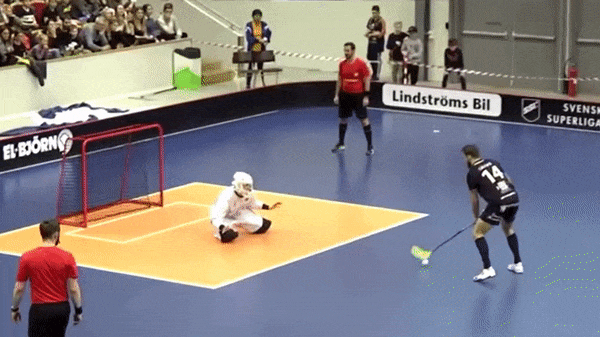
I would suggest you start your move the moment you’ve entered the crease or maybe even slightly earlier. This way, you keep the initiative, which hopefully means you’re always one step ahead of the goalie.
How to practice this at home – Just like tip 1, the best way to practice this at home is by watching penalty shots videos. Focus specifically on the moment every player starts his move; it’s usually once they’re entering the goal crease (the big square around the goal), just as suggested.
5. Shoot Low
If you move the ball quickly and then take a low shot, there is a good chance that the goalkeeper will not be able to reach the ground fast enough. In this case, you will often see that a goalkeeper is halfway his ‘dive movement’ towards the ground, but that the ball passes just below him.
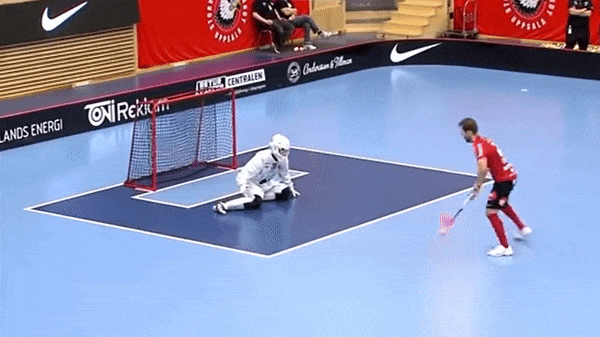
A high shot would have hit the goalkeeper, but this low option finds the net. So remember to keep your shot low, should you opt for this penalty shot. In the GIF above, you can see the goalie’s almost on the ground, but still too late to save the shot.
How to practice this at home – Try dribbling the ball sideways before making a fast shot forward, while keeping the ball low. You can practice this against a wall.
6. Use Your Reach
Anyone can learn an incredible number of things from penalty shooter Alexander Rudd. His stick handling, his decision-making, his technique – it all makes him one of the best penalty shooters of this time.
With tip 6, I want to focus on reach: the distance you can move the ball from left to right (preferably in a quick movement). It’s something Rudd uses a lot.
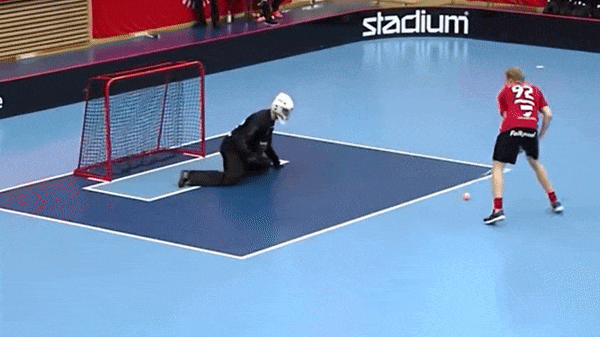
Try this for yourself: grab your stick and a ball, stand tall and move the ball in front of you, from left to right and back again. Do this using one hand only and see how big the distance is you’re covering. For me (1.79m tall, 96cm stick length), this is around 1.5m while standing tall.
Now see how you can increase this reach. Ideas:
- Get lower on your knees
- Move your upper body from left to right while dragging the ball sideways
- Take a quick step in between the movement
Why is this reach so important? For that, I have to explain the goalkeeper’s dilemma: during penalty shots, he has to choose between two options:
- During a penalty shot, the goalkeeper can stay on the goal line. Upside: he’s always in position. Downside: he covers little area of the goal.
- During a penalty shot, the goalkeeper comes forward to around 1-2m in front of the goal. Upside: he covers a bigger area of the goal cage. Downside: there’s the possibility the penalty taker can move the ball around him more easily.
Of course, the goalie won’t simply ‘pick’ option 1 OR 2, he’ll find the best of both worlds, depending on for instance his own size (the taller, the more he’ll cover using option 1) or speed (the faster, the easier he can cover sideways movement from the penalty taker).
To come to a conclusion regarding this tip: if you see that a goalkeeper moves out, you’ll benefit a lot if you have a large reach. Yes, it helps if you are tall and have a long stick – but it is also possible to achieve this effect without having to be 2m tall!
How to practice this at home – Most of the things have been mentioned already in this tip. Practice your wide zigzag movements, also with one hand to the stick instead of two. Make it fast and as wide as possible, perhaps with one or two steps in between to make the reach even bigger.
7. Practice Makes Perfect
Even though this tip looks like an open door, I’d like to discuss it. There are many aspects of a penalty shot that you can practice, even on your own.
Practice! Taking penalties is not only a technical act but also a psychological. You can practice your moves on your own (read below), and, once we can get back on the field again, you can find a goalie willing to help you for a couple of minutes.
What to practice? Well, I’ve covered many of them in the tips above already, but let’s summarize a few:
Practice on your stickhandling. Make sure you can move the ball quickly from left to right and from front to back. Also, practice this with only one hand on your stick (for lefties – people who have their stick to their left – this means that they always keep the right hand on top of the stick. Righties always keep their left hand on top of the stick).
It’s also important to be able to do these dribbles while walking forward or sideways, just like in a real penalty shot. Feint moves are also a thing to practice: e.g. give the ball a tap to the left and make a circle around it with your blade, sliding it over the ground. Or make a body feint to the right, after which you move explosively to the left.
8. Focus on the Goalkeeper’s Feet
From the feet, you can see which side the goalkeeper can slide to – and which side he can’t. From the viewpoint of the penalty taker: if the goalkeeper has his feet to the left, he can easily slide to the right, but hardly to the left. If he has his feet to the right, this is exactly the other way round.
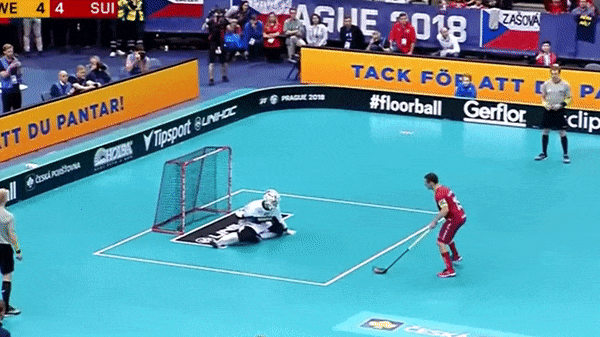
In the GIF above, Matthias Hofbauer (Switzerland) sees Mans Parsjo-Tegner (Sweden) has his feet on the left sight, seen from Hofbauer’s point of view. This means Parsjo-Tegner is able to dive to the right side easily, but might have trouble getting to the left. Hofbauer tricks the goalie to indeed dive to the right, after which its relatively easy for him to put the ball into the net.
How to practice this at home – Watch videos while focusing on the feet of the goalies.
9. Stand Lightly on Your Feet
In order to score a penalty shot, you need to be able to make short, fast movements (or just have a very good shot, like Galante’s goal at tip 1).
Therefore, make sure that you are light on your feet. You do not have to walk on your toes, but you do have to walk on the ball of your foot (your forefoot).
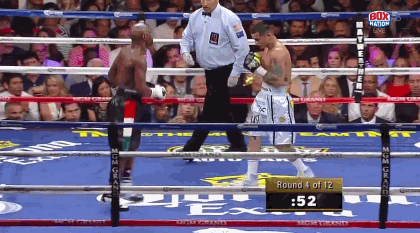
Like a boxer, you are much more agile in this way, can react to action from the goalie or are more likely to perform your feint successfully.
How to practice this at home – Rope skipping, or dribbling your feet while moving the ball. Check out how many steps Joakim Alvinder does:
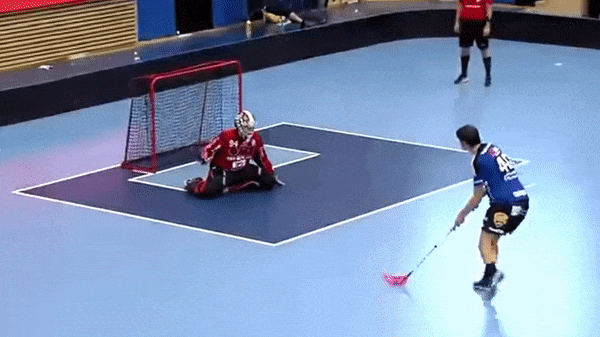
10. Zorro
With the introduction of the new penalty rules a few years ago (you are now allowed to move the ball backward, as long as you keep moving forward), the zorro has become increasingly popular as a penalty shot.
With this penalty you keep the ball in your blade. Ole Mossin Olesen (Norway) is a star in this:

If your skills are good enough to try to shoot a penalty like this, there’s a big chance you’ll score. However… it’s hard to master these skills, and that’s why I’ve placed this tip at the bottom of my list.
How to practice this at home – Start off very, very, very slowly and learn the movement of turning the ball around you, quickly moving the blade ‘over’ the ball to drag the ball back again. Tip to make practicing easier: grab an old blade, heat it up by using hot water or a hairdryer and bend a small ‘bowl’ in the tip of your blade. This will make it easier to practice.
11. Keep it easy (BONUS)
The simplest performance is usually the best one. Online you’ll find crazy penalty shots, awesome air hooking goals and more, but most of the time the penalties turning in a goal are the easy ones. Try it!
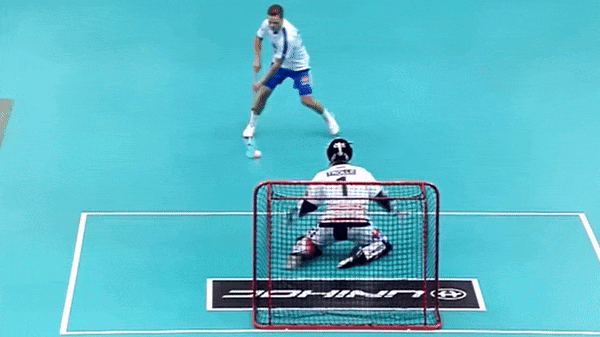
Do you often take penalty shots? Or do you have any more advice for penalty shooters? Let us know!
All penalty shots are from videos from our friends at FGFloorball. Make sure you subscribe to their YouTube channel!
[/ppp_patron_only]


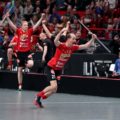

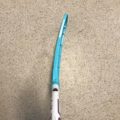


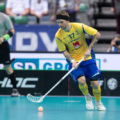
No Comments
Leave a comment Cancel